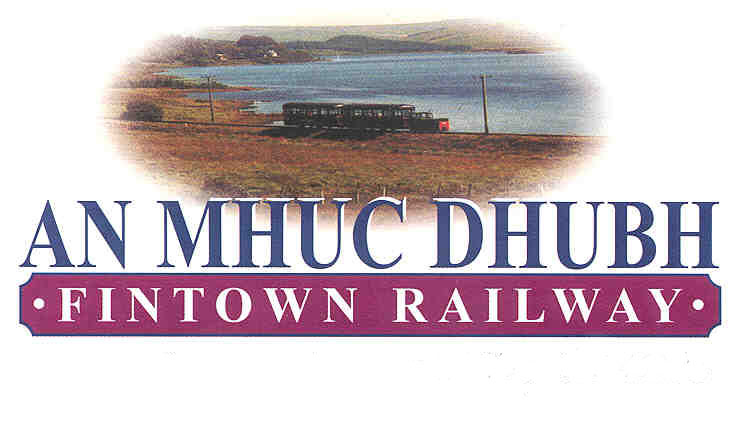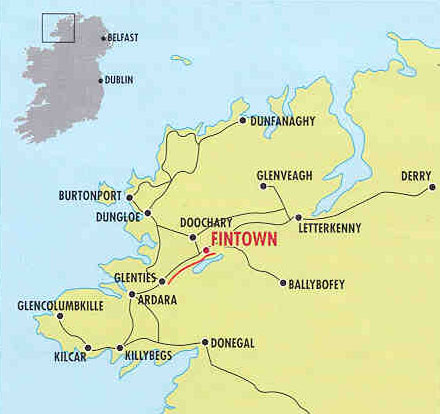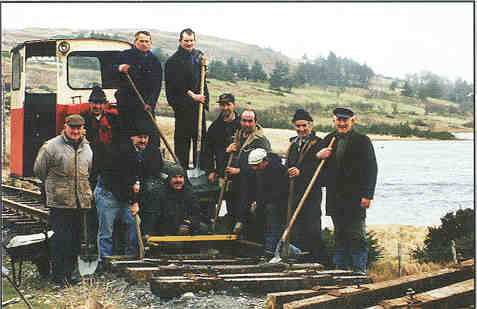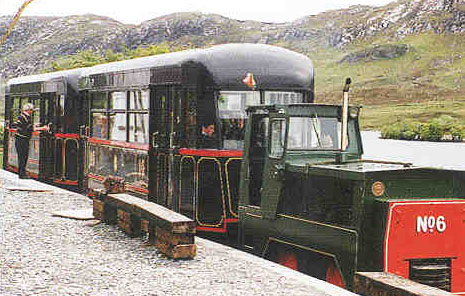

|
Districts Boards these lines were economic arteries which revolutionised the communities they served. 1889 saw permission given to construct the light railway between Glenties and Stranorlar, the line was to be 24 miles long. 1890 work began with the contracts undertaken by Mc Farlande of Derry. Because of bad work practices Mc Farlande lost the contract and the station at Cloghan had to be re-built. The Finn Vally Company finished the line and the first steam engine was heralded into Glenties by bell ringer on the 3rd June 1895. (This bell can still be seen in St. Connells Museum in Glenties). The service was in operation 4 times daily and the journey from Glenties to Stranorlar took - (Glenties-Fintown 20 minutes) and (Glenties-Stranorlar 1 hour). Steam powered locomotives were in operation at that time. Overnight, what was a days travel by horse |
| Cumann Traenach na Gaeltachta Lair was founded in 1991, its aim was to restore the entire length of Permanent Way from Fintown station to Glenties station. Following a line survey which was carried out with the help of Foyle Valley Railways with whom we have a very close association, it was recognised that whilst West Donegal is a relatively well known tourist destination with Fintown on the main east/west axis located within short distance of Glenveigh/Gartan and Dunlewey, Narin/Portnoo and Glencolmcille what it lacked was a heritage attraction capable of stopping and holding the passing visitor, providing much needed employment to this small area where there existed a large unemployment black spot. |

|
All the above became a reality on the 3rd of June 1995 (1895-1995) with the re-opening of the Railway. Since its closure in the sixties no work had been carried out until July 1993 when the first sod was turned by our Honerary President Brien Friel. Phase one of the project is the two and a quarter mile section from Fintown station to the west of the lake. Clearance work was undertaken by seven FAS employees armed with picks, shovels and barrows. Sceptics said that the removal of 40 years over growth without the use of diggers etc would be impossible but the men of Gaeltacht Lair proved them wrong! Eyebrows were again raised when the FAS team, their numbers now increased to thirty, started tracklaying in October 1994, the only additional aides being used were crowbars and sledgehammers. Consider the task the reballasting of the line to a depth of four to five inches, the sizing of sleepers, the levelling into position and the fitting of 60ft lengths of rail each weighing one tonne.

|
Words cannot adequately describe the quantity of work carried out by these FAS men with limited means in often harsh and inclement weather. The project is split into three phases for funding purposes and the time scale in which the work is to be completed. Included in the plans for phase one, together with the relaying of the two and a quarter miles of track, are the provision of a steam engine and a passenger boat on the lake. It is hoped to construct a visitors centre and shed to house the engine and carraiges. Other facilities planned for the station area are a childrens playground. Plans for the playground have been drawn up. It is a new and innovative plan to be constructed at the station area using local wood produce and labour. |
The project is now a reality and is a shining example of community self-help. Due to the many valuable and skilled FAS participants who have joined and left the project over the years, each participant had made their own valuable mark on the project. Various other projects such as the Cafe, angling society, youth hostel and the many varied services such as the transport services and shops have also benefited from our vision. We feel that what we have achieved to date cannot be adequately described in words - what is required is to experience this nostalgic trip first hand.
